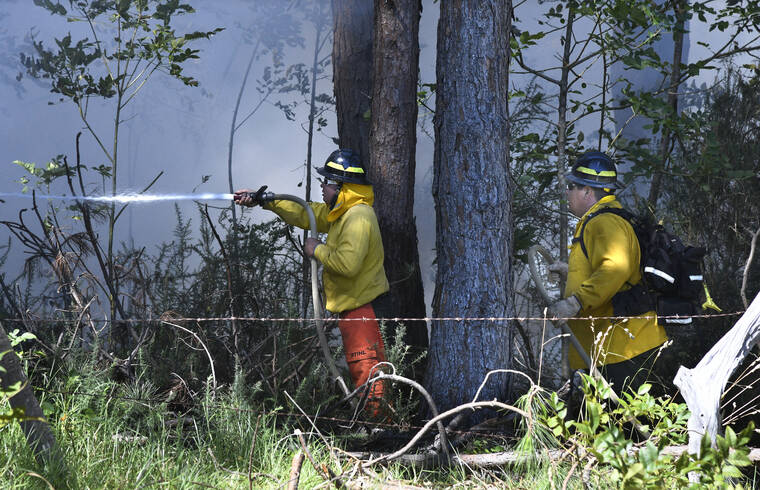DLNR ‘re-deploying’ water resource administrator

MATTHEW THAYER / THE MAUI NEWS VIA AP
Members of a state Department of Land and Natural Resources wildland firefighting crew on Maui battle a fire in Kula on Aug. 8.
The Department of Land and Natural Resources said it “is re-deploying” the state water resource administrator who was at the center of a delayed decision to divert water from Upcountry Maui land to help firefighters as the Aug. 8 wildfires began to take hold around Lahaina.
In a brief statement Wednesday night, DLNR officials said Kaleo Manuel, first deputy of the Commission on Water Resource Management, was being reassigned so that the commission and the department can “focus on the necessary work to assist the people of Maui recover from the devastation of wildfires.
“This deployment does not suggest that First Deputy Manuel did anything wrong. DLNR encourages the media and the public to avoid making judgments until all the facts are known,” the statement said.
On Aug 10, West Maui Land Co. sent a letter to Manuel describing the events and communication problems that resulted in delaying the diversion of streams to fill reservoirs with water that could be made available to fight the Aug. 8 fire.
Glenn Tremble, an executive with West Maui Land, declined to comment on his letter Tuesday, but a copy was obtained by the Honolulu Opens in a new tabStar-Advertiser Opens in a new tab.
According to the letter, although the initial fire was contained at 9 a.m. Tuesday, there were reports of fallen power lines, fierce winds, electrical outages and low reservoir levels, prompting the company to reach out to the commission to request approval to divert more water from streams so it could store as much water as possible for fire control.
Don't miss out on what's happening!
Stay in touch with breaking news, as it happens, conveniently in your email inbox. It's FREE!
Instead of approving the request, CWRM asked the company whether the Maui Fire Department had requested permission to dip into the reservoirs and directed executives to first inquire with the downstream user to ensure that his loi and other uses would not be impacted by a temporary reduction of water supply.
Communications were spotty, the letter said, and the company had already tried unsuccessfully to contact the sole downstream user. By around 3:30 p.m., a flare-up shut the Lahaina Bypass.
“At around 6:00 p.m., we received CWRM’s approval to divert more water,” Tremble wrote. “By then, we were unable to reach the siphon release to make the adjustments that would have allowed more water to fill our reservoirs.
Last summer, the commission designated the entire Lahaina Aquifer region as both a Surface Water and Ground Water Management Area. The designation, according to DLNR, gives the commission “the tools needed to identify actual uses, evaluate impacts and waste, address public trust priorities and balance needs, implement alternatives and plan for drought conditions.”
As part of the designation, in-stream flow standards were developed and designed to leave enough water for all users, including Native Hawaiian kalo farmers.
For decades, Native Hawaiians and environmentalists in West Maui and across Hawaii have been fighting to reverse the way water has been diverted from downstream users, a practice that was started by the large plantations.
DLNR said in its Wednesday statement that it “will have no further comment on this matter.“



